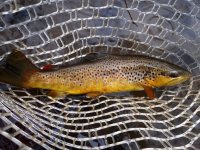Here is some info I found written by a FBC biologist on IDing wild trout:
Your question concerning the difference between stocked and wild trout has been forwarded to me for reply. During our field sampling, we are often confronted with having to identify whether a trout is wild or has been stocked. Sometimes, it can be a very difficult task indeed.
For the most part, the first thing we look at is fin wear. Recently stocked hatchery trout will have some degree of fin wear, particularly the caudal (tail), pectoral and dorsal fins. In contrast, wild fish will show very little of this type of fin wear. The difficulty in relying on fin wear for identification is that sometimes hatchery fish will come from small, low-density hatcheries such as those in our Cooperative Nursery program. Oftentimes these fish will show very little fin wear, which may lead you to believe they are wild trout. I've been stumped myself by these Cooperative Nursery trout.
Another thing to keep in mind is that worn fins will tend to "heal" on hatchery trout following stocking. Thus, differences in fin condition between stocked and wild trout become less and less distinct the longer the stocked fish has been in the wild. By late summer or early fall, it can be extremely difficult to tell a hatchery trout from a wild trout, even based on fin-wear. A few seasons ago we were sampling a stream in September and caught stocked hatchery brown trout that looked identical in every aspect to the wild brown trout that were also present in the stream. The only way we knew they were hatchery fish is that we had fin-clipped them in March prior to them being stocked. Although the clipped fin on these fish had grown back, they were altered in shape and readily identifiable.
Head size and body coloration are usually very poor indicators of hatchery or wild origin. If a proper diet is available, a stocked trout will "color up" relatively quickly. Much faster, in fact, than it would take for its fins to recover from hatchery wear. Additionally, I have sampled wild trout populations where many individuals had a very dull and drab coloration which is normally associated with hatchery fish. Head size and shape, body coloration, spotting patterns, etc... exhibit so much variation, even in wild populations, that I would be uncomfortable saying a trout was hatchery or wild based on those characteristics alone.
As you mentioned, fingerling trout can be very difficult to distinguish between hatchery and wild. One clue is that, generally, hatchery fingerlings tend to be larger in overall body size than wild fingerlings. However, this is a generalization and not a hard and fast rule. When we sample to assess the contribution of wild vs. stocked fingerlings to a population, we will fin clip the stocked fingerlings to be more easily identified after they are stocked.
One final method of identifying stocked from wild trout is to take scale samples and examine them under high magnification. The growth rings, or annuli, on the scale will look very different depending on whether the fish spent time in a hatchery or not. If the scales are from a hatchery fish, you will see abnormally fast rates of growth corresponding to the time period the fish spent in the hatchery. Once the fish is stocked, its growth will slow down and appear more like a wild fish. Although the equipment needed to use this method is impractical for use by the angler, this is the method I would use if I was unsure and really needed to know if a trout originated from a hatchery or from the wild.
Mr. Martin, I hope that I have answered your questions concerning identifying hatchery vs. wild trout. Outside of comparing scales under high magnification, telling hatchery from wild trout can be quite difficult at times, particularly during the late summer. Lots of practice, and knowing the stocking history of the watershed the trout came from can also be quite helpful in your determinations!
Good Luck Trout Fishing in 2007!
Regards,
Bob Weber
Coldwater Unit
Fisheries Management Division
Pennsylvania Fish and Boat Commission
Link to source: http://www.springcreekanglers.com/stockedorwildtrout.htm




